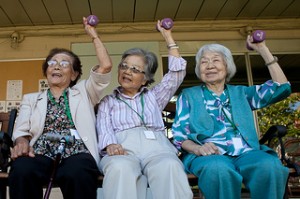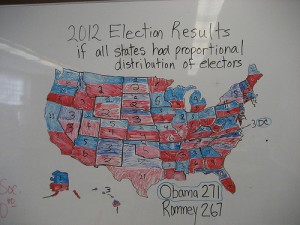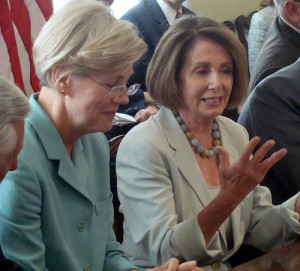Americans live in an aging society. As the Baby Boomers born after World War II retire, older people will become a larger segment of the U.S. population for at least the next two decades. Demand for federally funded Social Security and Medicare benefits will grow, and all fifty states will also face big challenges meeting the needs of elders. Our research shows that some states will do better than others in providing attractions and supports that matter for America’s graying citizens – and women serving in state legislatures will often be leaders in devising public policies that further care for the elderly in ways that improve the quality as well as length of life.
Previous research has documented that female state legislators are more interested than their male counterparts in supporting education and other public programs that meet the needs of families with children. To be sure, research to date leaves much more to be learned about the conditions that translate a female legislative presence into extra support for families. Democratic Party control of legislatures may magnify women’s influence, and so may an active women’s movement in any given state.
In addition to asking how women’s presence in legislatures translates into more support for families, we should also wonder about the extent of female legislative support. Does women’s legislative impact extend to policies that aim to help elders as well as younger families with children? And, if so, do states with more women in their legislatures actually prove to be better places for older people to live and flourish? We have investigated these issues as part of a broader project comparing state-level public policies that help people at various stages of aging.
Women Legislators and Age-Friendly Policies
Of course, the needs and concerns of older people are not all the same, and they tend to change as aging proceeds. Relatively young retirees often look for more meaningful pursuits than those possible in earlier stages of their educational or occupational lives, whereas older retirees become more concerned about maintaining their health and having access to high quality medical care. The oldest people may need long-term care and thus be interested in both its accessibility and quality. Government support for home and community-based care is especially valued by feeble seniors who hope to stay out of nursing facilities. The needs and concerns of older people are constantly in flux.Taking these varied priorities into account, we have identified and measured four key ways in which public policies in the fifty U.S. states make a difference for older residents – and we have checked to see if women in state legislatures tend to further each kind of public policy.
- Do states offer meaningful life pursuits through volunteer opportunities and supportive communities?
- Do states deliver quality health care for senior residents through Medicare-supported services from physicians and hospitals?
- Do states make high-quality facilities for long-term care accessible and affordable through Medicaid (which is jointly governed and funded by states and the federal government)?
- Do states adapt Medicaid to offer long-term care and services in the home and in community venues to aging residents who require extra daily help?
When we compare states according to how well they perform in these areas, legislatures with proportionally more women do make a difference, it turns out. For three of these four varying kinds of state efforts, we found that, as the proportion of state legislative seats held by women increases, so too does state support for age-friendly policies. In one policy realm, however, a greater female presence is associated with a less age-friendly outcome: states with more women in their legislatures are less likely to support accessible, high quality nursing home facilities funded by Medicaid. But this downside goes hand in hand with what might be considered an upside in the eyes of many older Americans, because states that do less to foster nursing facilities tend to support home and community-based forms of long-term care. Many seniors want non-institutional kinds of care, so it may well be that women legislators are more in tune with the preferences of their states’ older residents than are their male counterparts.
Age-Friendly Policies Make a Real Difference

In our comparisons of the U.S. states as sites for meaningful, healthy aging, we went beyond just tallying up different kinds of community facilities and public programs – to see if different policies add up to real-life differences for older people. In key respects, the answer is yes; different state policies do matter. States with strong community supports and volunteer opportunities do enhance the sense that life is meaningful for older residents, and good quality health care through Medicare is positively and strongly related to life expectancy. Healthier seniors live longer in states with good quality care. In addition, both accessible, good quality nursing facilities and community-based long-term care programs also lengthen lives and improve the quality of life for older men and women.
A clear bottom line thus emerges from our research exploring political, policy, and social patterns across the U.S. states. A stronger presence of women in state legislatures turns out to be good for older men and women. Just as female legislators weigh in on behalf of meeting the needs of families with children, they also appear more likely than male legislators to further policies that make a real difference in medical care and community support for senior residents. As the United States moves deeper into an era where support and care for older people will be an ever more central concern in society and public policy, the growing presence of elected female legislators will almost certainly help the United States face these issues and find family-friendly solutions. Toward the end of life as well as at its beginning and during the middle, women in office seem sensitive to the practical concerns of families and individuals in need of support. Across America, the states whose voters more often send women to serve in their legislatures are therefore likely to be the states best prepared to meet the growing challenges of an aging population.










 Research to Improve Policy: The Scholars Strategy Network seeks to improve public policy and strengthen democracy by organizing scholars working in America's colleges and universities. SSN's founding director is Theda Skocpol, Victor S. Thomas Professor of Government and Sociology at Harvard University.
Research to Improve Policy: The Scholars Strategy Network seeks to improve public policy and strengthen democracy by organizing scholars working in America's colleges and universities. SSN's founding director is Theda Skocpol, Victor S. Thomas Professor of Government and Sociology at Harvard University.